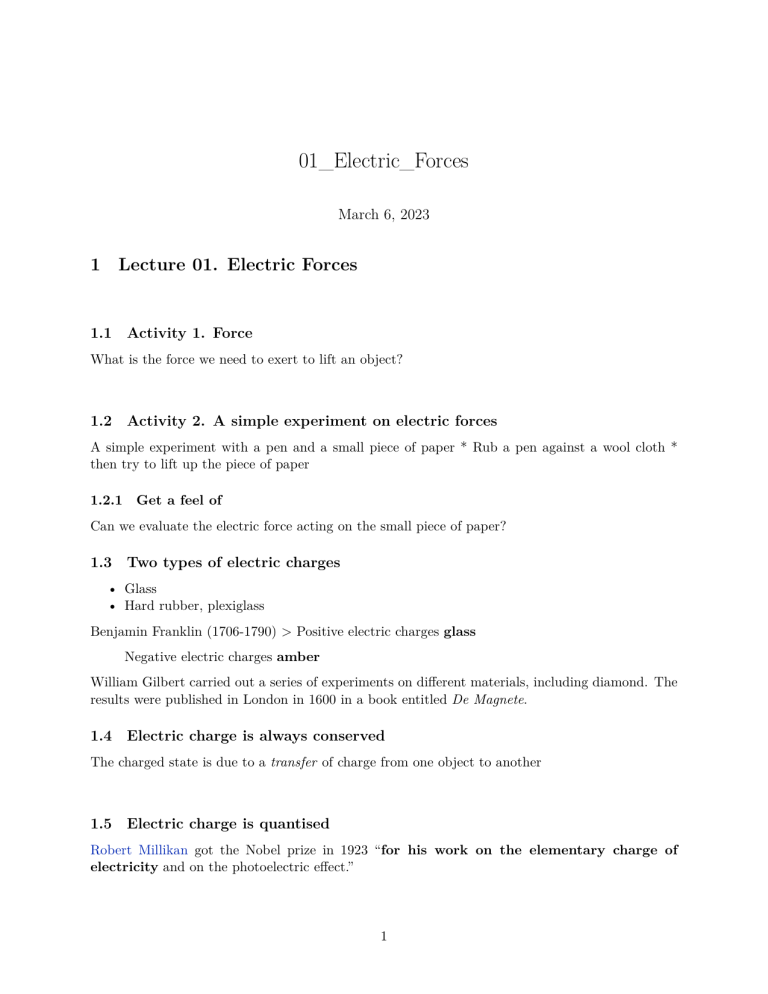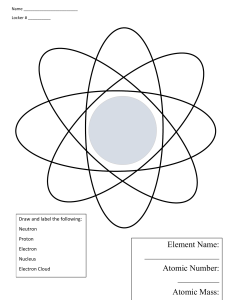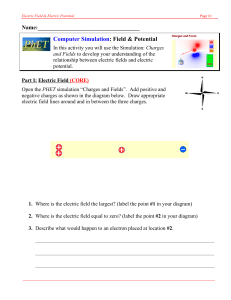Electric Forces Lecture Notes: Charge, Conductors, Insulators
advertisement

01_Electric_Forces March 6, 2023 1 Lecture 01. Electric Forces 1.1 Activity 1. Force What is the force we need to exert to lift an object? 1.2 Activity 2. A simple experiment on electric forces A simple experiment with a pen and a small piece of paper * Rub a pen against a wool cloth * then try to lift up the piece of paper 1.2.1 Get a feel of Can we evaluate the electric force acting on the small piece of paper? 1.3 Two types of electric charges • Glass • Hard rubber, plexiglass Benjamin Franklin (1706-1790) > Positive electric charges glass Negative electric charges amber William Gilbert carried out a series of experiments on different materials, including diamond. The results were published in London in 1600 in a book entitled De Magnete. 1.4 Electric charge is always conserved The charged state is due to a transfer of charge from one object to another 1.5 Electric charge is quantised Robert Millikan got the Nobel prize in 1923 “for his work on the elementary charge of electricity and on the photoelectric effect.” 1 The smallest electric charge is the charge of the electron 1.6 Microscopic structure of matter Particle Mass Charge Electron (e) Proton (p) Neutron (n) 9.109 x 10-31 kg 1.672 x 10-27 kg 1.674 x 10-27 kg -1.602 x 10-19 C +1.602 x 10-19 C 0 Atomic radius ≃ 0.53 x 10-10 m Nuclear radius ≃ 10-15 - 10-14 m 1.6.1 Get a feel of • Calculate the ratio between mp (mass of the proton) and me (mass of the electron) • How to propose a scale representation for the mass of the electron and the proton? Scaled mass: – The mass of a coin corresponding to 20 Euro cents is 5.74 grams If we use the coin to represent the mass of an electron, how big would be the mass of a proton? Observation • The mass of the atom is concentrated mainly in its nucleus • Scaled radius: – A man stands with open arms. The distance from one hand to the other is about 1.5 meters If we use this distance to represent the nuclear radius, how big will be the atomic radius? Observation • The volume of the atom consists mostly of empty space 1.7 1.7.1 A classification of the materials Electrical conductors In eletrical conductors some of the electrons are free to move inside the material Examples: metals, including copper, aluminium and silver 1.7.2 Electrical insulators In electrical insulators all electrons are bound to atoms and cannot move freely through the material 2 Examples: glass, rubber, dry wood 1.7.3 Semiconductors Examples: silicon, germanium 1.8 Charging by contact 3





